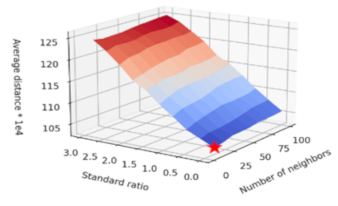
Point clouds generated from 3D scans of part surfaces consist of discrete 3D points, some of which may be incorrect, or outliers. Outlier points can be caused by the scanning method, part surface attributes, and data acquisition techniques. Filtering techniques to remove these outliers from point clouds frequently require a “guess and check” method to determine proper filter parameters. This paper presents two novel approaches to automatically determine proper filter parameters using the relationships among point cloud outlier removal, principal component variance, and the average nearest neighbor distance. Two post-processing workflows were developed that reduce outlier frequency in point clouds using these relationships. These post-processing workflows were applied to point clouds with artificially generated noise and outliers along with two real-world point clouds. Analysis of the results showed both approaches effectively reducing outlier frequency when used in suitable circumstances.

With the mandatory introduction of the May 2011 directive for reassessment of bridges in Germany, the administrations of the federal and state governments have the duty to prove the stability of their bridge stock. Verification of bridge stability will be realized with consideration of the newly increased traffic loads. Particularly in older bridges, the verification can only be achieved if calculative surplus load capacity of the original structural design is taken into account in the recalculation. One option for considering these reserves is the exact determination of the dead weight of the bridge. Within this case study, it will be demonstrated how the problem can be practically solved. In order to determine the dead weight of a concrete bridge, its volume has to be calculated. as a first step, a 3D laser scanner is used to record the internal geometry of a hollow box bridge girder. For the determination of the thickness of the concrete member, the non-destructive technique ultrasonic echo is applied. The construction must be segmented in approximately equidistant parts in order to be able to carry out an economic and efficient investigation. The description of the segmentation of the point cloud, carried out in a 2D model, was presented in the first part of the publication. The subject of this presentation is the merging of 2D cross sections into a 3D model, from which the weight of the bridge can be calculated.